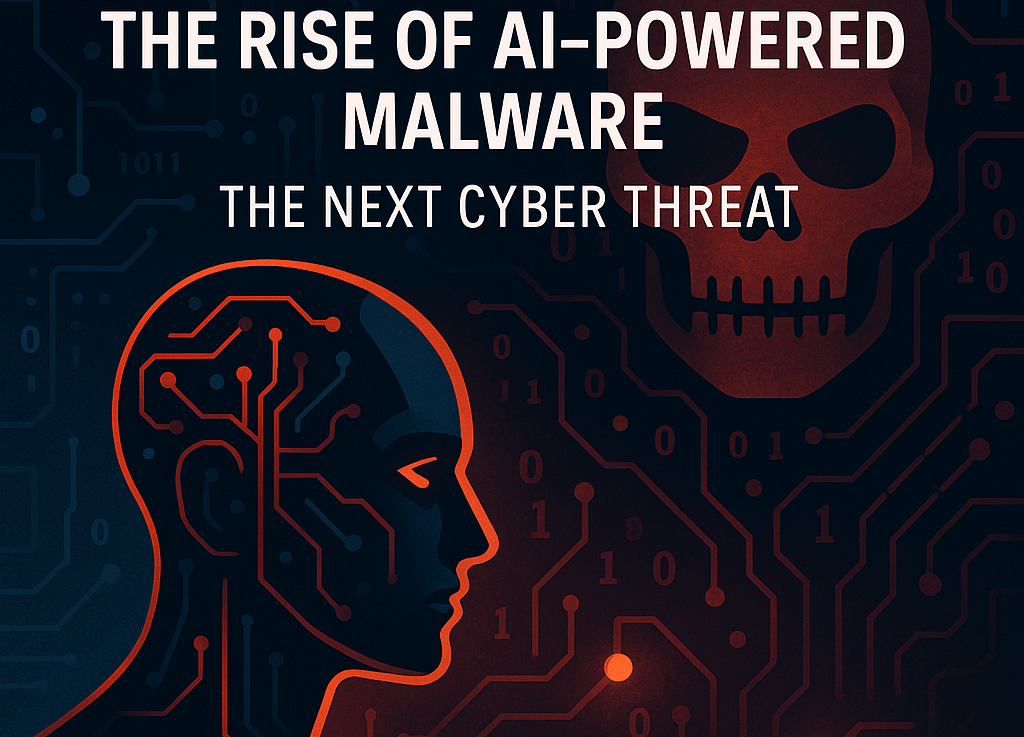The Rise of AI-Powered Malware: The Next Cyber Threat
AI is revolutionising cybersecurity, but it’s also arming cybercriminals with powerful new tools. The Rise of AI-Powered Malware: The Next Cyber Threat explores how AI-driven malware is making cyberattacks more sophisticated, adaptive, and harder to detect. Unlike traditional malware, AI-powered threats can evolve in real time, bypassing security measures and launching highly targeted attacks. This blog delves into the dangers of AI in cybercrime, how it works, and the proactive defence strategies organisations must adopt to stay ahead. As the battle between AI-powered attackers and defenders intensifies, staying informed is the first step toward cybersecurity resilience.
Kerlyn Manyi
4/2/20253 min read


AI: A Double-Edged Sword in Cybersecurity
Artificial Intelligence is transforming industries by automating processes, improving security, and enhancing efficiency. In cybersecurity, AI helps detect fraud, identify anomalies, and respond to threats in real time. However, as much as AI is being used for defense, it is also becoming a powerful tool for attackers. Cybercriminals are now leveraging AI and machine learning to create malware that is more advanced, adaptable, and difficult to detect.
Unlike traditional malware, which follows pre-written code, AI-powered malware can analyze its environment, change its tactics, and even learn from failed attacks. This makes it far more dangerous than conventional threats, as it can bypass security defenses, launch highly targeted attacks, and remain undetected for extended periods. The use of AI in cybercrime is growing, and organizations must prepare for a future where AI-driven threats become the norm.
Why AI-Powered Malware is So Dangerous?
Traditional malware operates based on fixed patterns, which security tools can eventually recognize and neutralize. AI-powered malware, however, is dynamic. It continuously adapts, making detection much more difficult. One of its biggest advantages is its ability to carry out highly targeted attacks. By analyzing large amounts of data, AI-driven malware can craft phishing emails or ransomware attacks that are nearly indistinguishable from legitimate communications. This increases the likelihood of success, as victims are more easily deceived.
Another major concern is its ability to rewrite its code. AI-powered malware can modify itself in real time, evading detection from antivirus programs and security software. Even if one version of the malware is identified, it can generate a new variation, allowing it to continue operating undetected.
Stealth is also a critical factor. AI-powered malware can recognize when it is being analyzed in a security sandbox and remain dormant until it reaches its real target. It can also use encrypted communication to avoid detection while carrying out attacks. These capabilities make AI-driven malware a serious challenge for security teams, as traditional defenses struggle to keep up with its evolving nature.
How AI-Powered Malware Works?
Unlike conventional malware that follows a set script, AI-powered malware is capable of making real-time decisions and adapting its behaviour based on its environment. This allows it to bypass security measures that rely on static detection methods. It can analyze network traffic, identify weak points, and exploit vulnerabilities with greater precision.
One of its most dangerous features is its ability to personalize attacks. By gathering information from emails, social media, and other sources, AI-driven malware can craft highly convincing phishing attempts that target specific individuals or organizations. This increases the success rate of cyberattacks and makes traditional phishing detection methods less effective.
AI-powered malware also excels at evading detection. It can modify its code, disguise its activity, and even use deception techniques to trick security software. Some versions can detect when they are being monitored and adjust their behavior to avoid raising suspicion. This level of adaptability makes it one of the most challenging cyber threats to combat.
Defending Against AI-Powered Malware:
As AI-powered malware becomes more sophisticated, organizations must take a proactive approach to cybersecurity. Relying on traditional security tools is no longer enough. Instead, companies must adopt AI-driven security solutions that can detect and respond to threats in real time. Machine learning-based security systems are essential, as they can analyze behavior and identify anomalies that indicate an attack.
Automating incident response is another key defense strategy. AI-powered security tools can detect threats faster than human analysts and respond immediately, preventing further damage. Implementing a Zero Trust security model is also critical. By enforcing strict access controls and continuous authentication, organizations can limit the impact of an attack if malware does manage to breach their defenses.
Threat intelligence sharing is becoming increasingly important as well. Since AI-powered threats evolve rapidly, organizations need to collaborate and share insights about new attack techniques. Staying informed about emerging threats allows security teams to adapt and strengthen their defenses before they become targets.
Training employees to recognize AI-powered phishing and deepfake scams is another crucial step. As cybercriminals use AI to create more convincing fraudulent communications, user awareness remains a critical line of defense. Organizations that invest in security education and AI-driven protection strategies will be better prepared to combat the rising threat of AI-powered malware.
Conclusion:
AI-powered malware represents a major shift in the cybersecurity landscape. Its ability to learn, adapt, and automate attacks makes it far more dangerous than traditional threats. Organizations must embrace AI-driven security solutions, implement stronger defense strategies, and stay ahead of evolving cyber risks. As AI continues to shape the future of cybersecurity, the battle between AI-powered attackers and AI-driven defenders has already begun. The question is no longer whether AI-powered malware will become a serious problem—it already has. The real challenge is ensuring that cybersecurity measures evolve fast enough to keep up.
